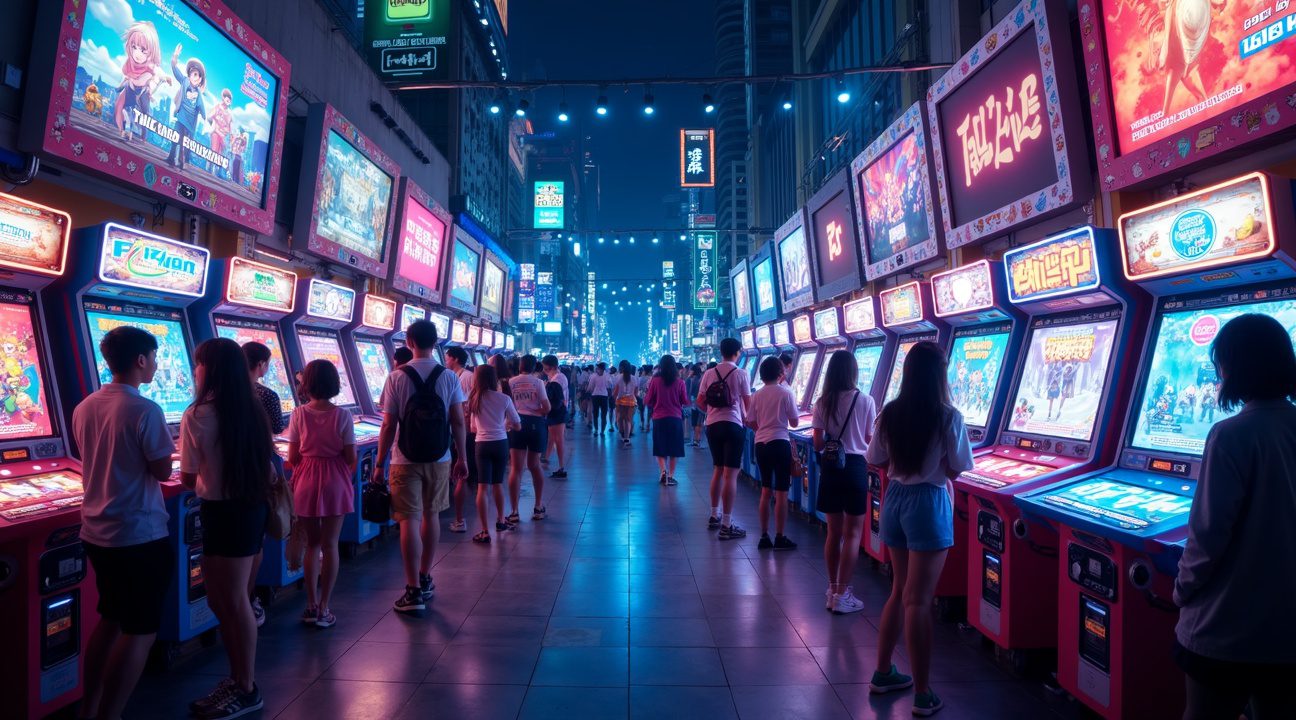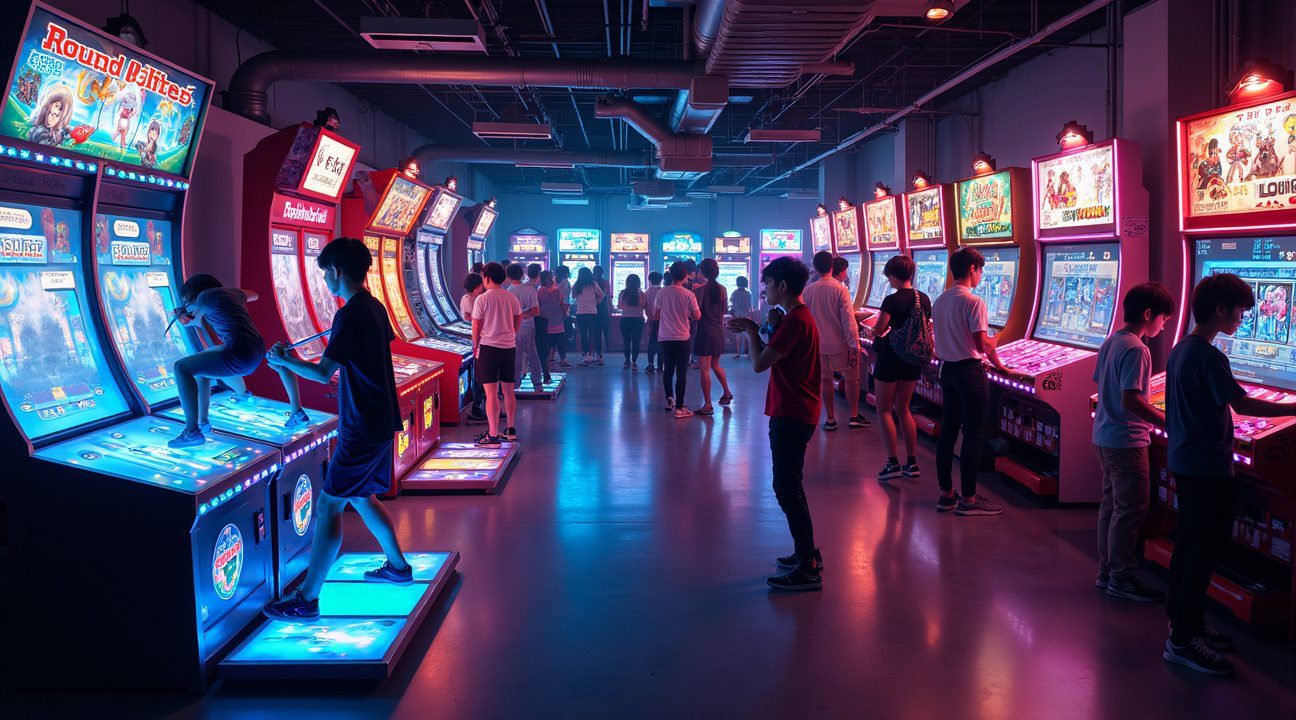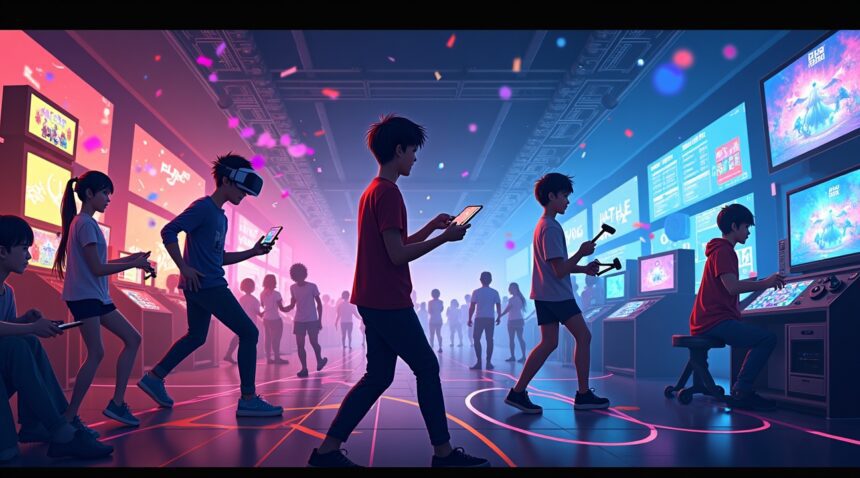Rhythm games today exist in a dramatically changed landscape where mobile platforms dominate with projected revenues of $2.5 billion by 2025, while traditional console, arcade, and PC segments defend their territory through specialized hardware experiences and emerging technologies like VR and AI.
The Asia Pacific region has emerged as the global rhythm gaming capital, driving innovation across all platforms. Arcade classics like Dance Dance Revolution and Taiko no Tatsujin continue to thrive alongside sophisticated esports tournaments, which help to legitimize competitive rhythm gaming.
Key Takeaways
- Mobile rhythm games are experiencing explosive growth with a 15% compound annual growth rate projected through 2033, thanks to free-to-play models and in-app purchase monetization strategies.
- The Asia Pacific region leads the global rhythm gaming market due to widespread mobile adoption, a thriving arcade culture, and tech-savvy consumer bases that actively embrace interactive entertainment innovations.
- Console and PC platforms continue to hold ground through specialized hardware experiences, franchise powerhouses like Guitar Hero and Beat Saber, and advanced audio processing capabilities that remain beyond the reach of most mobile devices.
- Esports is helping transform rhythm games into recognized competitive formats, complete with substantial prize pools, professional broadcasting systems, and strategic partnerships that appeal to a wide range of audiences beyond traditional gamers.
- AI and VR technologies are revolutionizing rhythm gaming by enabling personalized content generation, immersive 3D musical environments, and adaptive gameplay systems that tailor experiences to the individual player’s preferences and skill levels.
For more insights into how innovations are reshaping gaming, explore this detailed overview of mobile rhythm game market revenues.
How Mobile Gaming is Eating the Rhythm Game Market’s Lunch
I can see exactly why traditional rhythm game platforms are feeling the pressure. The numbers tell a compelling story about where this industry is headed. Mobile rhythm games are projected to reach $2.5 billion in 2025, with a remarkable Compound Annual Growth Rate (CAGR) of 15% stretching from 2025 to 2033. Some industry reports paint an even more aggressive picture, estimating the 2024 market size at $3.5 billion and projecting growth to $7.2 billion by 2033, albeit with a slightly more conservative CAGR of 8.5%.
This explosive expansion isn’t happening in a vacuum. I’ve watched the rhythm game space transform dramatically as mobile platforms leverage advantages that traditional consoles and arcade cabinets simply can’t match. The free-to-play model has become the driving force behind this growth, removing the barrier of upfront costs that often deterred casual players from exploring rhythm games in the past.
The Economics of Mobile Dominance
Mobile developers have cracked the code on sustainable monetization through in-app purchases and sophisticated engagement systems. Instead of relying on one-time game sales like traditional platforms, these games create ongoing revenue streams that keep players invested long-term. I’ve noticed how features like daily challenges, seasonal events, and progression systems work together to maintain player engagement far beyond what single-purchase games typically achieve.
- In-app purchases allow users to personalize experiences
- Seasonal content updates keep games relevant and exciting
- Progression systems encourage player retention and replayability
Android commands the largest share of the mobile rhythm gaming market compared to iOS, primarily due to its broader device penetration and widespread adoption in emerging markets. This platform dominance has significant implications for developers and players alike, as it shapes everything from development priorities to music licensing strategies.
The shift has profound implications for traditional platforms. Console rhythm games like fighting game franchises that incorporate rhythm elements now compete against mobile experiences that offer similar gameplay mechanics with the added convenience of portability. Arcade operators face even steeper challenges, as mobile games deliver rhythm gaming experiences directly to players’ pockets without requiring physical visits to gaming venues.
This mobile revolution has also democratized access to rhythm gaming across global markets. Players in regions where console gaming remains expensive can now access high-quality rhythm experiences on devices they already own. The Asia Pacific region has emerged as a particularly strong market for mobile rhythm games, driving much of the industry’s growth and innovation.
Mobile platforms continue reshaping expectations around content delivery, with regular updates and fresh music libraries becoming standard rather than exceptional. This constant content refresh cycle has become something players expect from modern rhythm games, putting pressure on traditional platforms to adapt their update strategies.

Why Asia Pacific is the Rhythm Gaming Capital of the World
Asia Pacific has emerged as the undisputed global leader in rhythm gaming, driven by a perfect storm of demographic, technological, and cultural factors. Countries like China, Japan, and South Korea represent the fastest-growing markets for rhythm games, benefiting from large youth populations who’ve grown up with interactive entertainment as a core part of their social lives.
The region’s widespread adoption of mobile technology creates an ideal environment for rhythm gaming growth. Asian consumers demonstrate remarkable enthusiasm for new trends in interactive entertainment, making them early adopters of innovative rhythm game mechanics and formats. This tech-savvy consumer base actively seeks out fresh experiences, pushing developers to create increasingly sophisticated and engaging content.
Arcade Culture Dominance
While arcade rhythm games remain a niche pastime in Western markets, they serve as centerpieces of gaming culture throughout the Asia Pacific region. Japan, Korea, and Taiwan maintain thriving arcade scenes where titles like Dance Dance Revolution and Taiko no Tatsujin attract dedicated communities of players. These establishments function as social hubs where rhythm gaming enthusiasts gather to compete, practice, and share their passion.
Several factors contribute to arcade rhythm gaming success in Asia Pacific:
- Cultural integration that views arcade gaming as a legitimate social activity rather than juvenile entertainment
- Regular addition of new music content that keeps experiences fresh and relevant to local audiences
- Frequent local competitions that foster community engagement and skill development
- High-quality arcade hardware that delivers superior audio-visual experiences compared to home setups
Japan stands out as a particularly strong example of sustained arcade rhythm gaming success. The country’s enduring popularity for arcade rhythm games has helped maintain a robust arcade scene, even as other global regions have experienced significant declines in arcade attendance. Japanese arcades continue to invest in cutting-edge rhythm gaming cabinets, creating immersive experiences that can’t be replicated at home.
The social aspect of arcade rhythm gaming plays a crucial role in Asia Pacific’s dominance. Players gather to watch skilled performers tackle challenging songs, creating spectator experiences that build community around individual achievements. This social dynamic transforms rhythm gaming from solitary entertainment into shared cultural experiences that strengthen player engagement and retention.
Market trends indicate that Asia Pacific’s leadership in rhythm gaming will continue expanding. The region’s combination of technological infrastructure, cultural acceptance, and active player communities creates sustainable conditions for ongoing growth. Developers increasingly focus their content creation efforts on Asian markets, recognizing that success in these regions often translates to global viability.
Mobile rhythm gaming particularly thrives in Asia Pacific markets, where smartphone adoption rates exceed global averages and mobile gaming generates substantial revenue. Players appreciate the convenience of accessing rhythm games anywhere while maintaining the competitive spirit that drives arcade culture. This mobile revolution complements rather than replaces arcade experiences, creating multiple touchpoints for rhythm gaming engagement.
The Asia Pacific region’s status as the rhythm gaming capital reflects broader shifts in global gaming preferences and cultural attitudes about interactive entertainment. As other regions begin to recognize rhythm gaming’s appeal, they often look to Asian markets for inspiration and best practices, cementing the region’s influence on worldwide rhythm gaming development and distribution strategies.

Console and PC Players Fight to Stay Relevant
I’ve watched console and PC rhythm gaming carve out its own determined path in an increasingly mobile-dominated landscape. The console and PC market stands valued at $1.5 billion in 2024, with projections reaching $3.2 billion by 2033 and a compound annual growth rate of 9.2% from 2026 onward. These figures demonstrate that traditional platforms aren’t simply surviving—they’re actively growing.
Console and PC rhythm games leverage advanced hardware capabilities that mobile devices can’t match. Players experience rich visual effects, complex control schemes, and premium production values that create deeper gameplay complexity. This technical advantage becomes particularly evident in franchises that demand precision timing and sophisticated input methods, where dedicated controllers and keyboards provide tactile feedback mobile screens simply can’t deliver.
Franchise Powerhouses Drive Platform Loyalty
Several key franchises continue anchoring this market segment through innovation and community engagement. Guitar Hero maintains its legendary status among rhythm gaming enthusiasts, while Rock Band preserves the collaborative music-making experience that defined a generation. Just Dance 2023 brings motion-controlled gaming to living rooms worldwide, proving that physical interaction remains compelling.
Beat Saber has revolutionized the space through VR integration, creating immersive experiences where players slice through beats in three-dimensional space. This title alone demonstrates how console and PC platforms can deliver experiences impossible on mobile devices. Taiko no Tatsufin continues celebrating Japanese drumming culture with authentic controller support, while Dance Dance Revolution lives on through adapters and remasters that honor its arcade legacy.
I notice that these franchises share common traits: they prioritize hardware-specific features, offer extensive customization options, and foster communities around shared equipment experiences. Players invest in specialized controllers, from plastic guitars to drum kits, creating barriers to entry that simultaneously build deeper engagement.
The PC platform particularly excels in supporting community-generated content. Modding communities create endless song libraries, custom charts, and gameplay modifications that extend these games’ lifespans far beyond their original releases. This user-generated content ecosystem proves especially valuable for titles like Beat Saber, where community creativity drives content diversity.
Console exclusives also play crucial roles in maintaining platform relevance. Tekken 8 incorporates rhythm elements within its fighting mechanics, while Persona games blend rhythm gameplay with storytelling in ways mobile platforms struggle to replicate. These hybrid approaches expand rhythm gaming’s definition while showcasing console capabilities.
Advanced audio processing represents another console and PC advantage. High-fidelity sound systems, surround sound capabilities, and low-latency audio processing create precise timing feedback essential for competitive play. Professional rhythm gamers often prefer these platforms specifically for their audio precision and consistent performance characteristics.
Cross-platform compatibility has become increasingly important as developers recognize the need to bridge mobile and traditional gaming audiences. Many console rhythm games now offer companion mobile apps or cross-platform progression systems, acknowledging that players want flexibility across devices while maintaining their preference for premium experiences on traditional platforms.
The competitive gaming scene further solidifies console and PC relevance. Professional gaming tournaments typically center around console or PC versions due to their standardized hardware specifications and reduced input lag. This competitive ecosystem creates aspirational value that drives enthusiast purchasing decisions.
Looking ahead, console and PC rhythm gaming faces the challenge of balancing accessibility with depth. While mobile gaming captures casual audiences through convenience, traditional platforms must continue innovating through VR integration, haptic feedback, and emerging display technologies. Successful franchises understand that survival depends on offering experiences genuinely impossible elsewhere, rather than simply porting mobile concepts to premium hardware.
Arcade Legends That Refuse to Die
Classic arcade rhythm games continue to thrive in an era dominated by mobile gaming, proving that physical interaction and social experiences remain irreplaceable. Dance Dance Revolution stands as the most recognizable title, with its iconic four-panel dance platform drawing players of all skill levels. I’ve witnessed countless arcade sessions where DDR transforms casual visitors into dedicated dancers, creating spontaneous communities around shared challenges and friendly competition.
The Power of Physical Interaction
Sophisticated arcade cabinets elevate these experiences far beyond what mobile devices can offer. Taiko no Tatsujin provides players with actual drum surfaces and weighted drumsticks, delivering authentic haptic feedback that mobile rhythm games simply can’t replicate. Sound Voltex features analog knobs and multiple button configurations that create a tactile symphony, while maimai‘s circular touch interface surrounds players in an immersive 360-degree experience. These physical elements transform gameplay from simple button pressing into full-body engagement.
Beatmania IIDX showcases the complexity that arcade hardware enables, with its seven-key turntable setup creating depth that appeals to serious rhythm game enthusiasts. Jubeat‘s grid-based interface encourages collaborative play, as multiple players can share strategies and techniques in real-time. Each machine represents a significant investment in specialized hardware that mobile platforms can’t match, justifying their continued presence in arcades worldwide.
Community-Driven Culture
Location-based experiences foster communities that mobile gaming struggles to create. I’ve observed how arcade rhythm games naturally generate social interactions, with players sharing techniques, celebrating high scores, and forming lasting friendships. These games serve as cultural gathering points where music fans and gamers intersect, creating diverse communities united by shared passion.
Competitive events amplify this social aspect, with players traveling significant distances to participate in tournaments featuring these classic titles. The communal nature extends beyond individual play sessions, as regular arcade visitors develop relationships with staff and fellow players. This creates loyalty that keeps people returning despite the convenience and lower cost of mobile alternatives.
The arcade experience offers several advantages that mobile rhythm games haven’t replicated:
- Physical cabinets provide consistent, professional-grade controllers that enhance precision and reliability
- Larger screens and powerful audio systems create immersive environments impossible on personal devices
- Shared spaces encourage learning through observation and direct interaction with skilled players
- Specialized hardware enables unique gameplay mechanics not feasible on touchscreens
Cultural significance plays a crucial role in sustaining these arcade legends. Tekken 8 demonstrates how fighting games maintain arcade relevance, and rhythm games follow similar patterns by preserving traditions while updating content. Many players view arcade visits as social outings rather than solitary gaming sessions, making the experience about more than individual achievement.
The persistence of these titles challenges assumptions about mobile gaming’s dominance. While apps offer convenience and accessibility, they can’t replicate the visceral satisfaction of hitting physical drums or the excitement of group play around a cabinet. Arcade operators have adapted by creating hybrid experiences that incorporate modern elements like online leaderboards and social media integration while preserving core physical gameplay.
These games succeed by offering something fundamentally different from home gaming. The investment required to visit an arcade creates commitment that enhances the experience’s value. Players appreciate the quality and maintenance of professional equipment, which consistently delivers optimal performance compared to wear-prone mobile devices.
Regular content updates keep these titles fresh, with new songs and challenges maintaining player engagement across generations. The shared nature of arcade gaming means that updates benefit entire communities simultaneously, creating collective excitement that individual mobile experiences rarely match.
The enduring popularity of DDR, Taiko no Tatsujin, and their contemporaries proves that certain gaming experiences resist digitization. Their combination of physical interaction, social elements, and specialized hardware creates unique value propositions that explain their continued success in modern gaming landscapes.
https://www.youtube.com/watch?v=j1fGzKAy1yE

Esports Tournaments Are Making Rhythm Games Mainstream Again
I’ve watched rhythm games transform from arcade curiosities into legitimate esports contenders over the past few years. Major tournaments now feature substantial prize pools and draw thousands of viewers worldwide, proving that competitive rhythm gaming has found its place in the modern esports landscape. Strategic partnerships between tournament organizers and renowned music artists create unique experiences that blend gaming with live entertainment, attracting audiences who might never have considered watching competitive gaming before.
Mobile platform tournaments have particularly exploded in popularity, with events drawing viewership numbers that rival traditional fighting game competitions. Sponsors recognize the value in these events because they reach diverse demographics, including music enthusiasts and casual mobile gamers who represent significant purchasing power. Prize pools have grown substantially as organizers understand that financial incentives help legitimize rhythm games as serious competitive pursuits rather than casual entertainment.
Technology Advances Drive Competitive Excellence
Enhanced graphical fidelity and precision sound design have elevated rhythm games to new competitive standards that I believe match any traditional esport. Modern rhythm games feature frame-perfect timing systems and ultra-responsive controls that allow for incredibly precise competitive play. These technical improvements create a skill ceiling high enough to support professional-level competition while remaining accessible to newcomers.
Cross-platform compatibility has revolutionized how players connect and compete across different devices and gaming systems. Competitors can now participate in tournaments regardless of whether they prefer mobile, console, or arcade platforms, dramatically expanding the potential player base. This technological flexibility has proven crucial for organizers seeking to maximize participation and viewership.
Social integration features have transformed rhythm games from solitary experiences into community-driven competitive platforms. Real-time leaderboards, spectator modes, and interactive streaming capabilities allow fans to engage directly with competitive events. Players can share their performances instantly across social media platforms, creating viral moments that extend far beyond traditional gaming communities.
Competitive modes now incorporate sophisticated matchmaking systems that ensure fair competition while maintaining engagement for players of all skill levels. I’ve seen how these systems successfully balance the need for challenging high-level play with accessible entry points for newcomers. Advanced analytics help tournament organizers understand viewing patterns and player preferences, enabling them to create more engaging competitive formats.
The integration of rhythm games into major gaming conventions and esports events has provided unprecedented exposure to mainstream audiences. Just Dance 2023 tournaments at gaming expos demonstrate how traditional publishers now view competitive rhythm gaming as a valuable marketing opportunity. These events often feature celebrity appearances and exclusive music previews that generate significant media coverage.
Professional rhythm game players have developed training regimens and analytical approaches that mirror those found in traditional sports. Competitors study frame data, practice specific patterns for hours, and develop muscle memory for complex sequences. This dedication has elevated the skill level dramatically, creating spectacular displays of human precision and musical timing that captivate audiences.
Broadcasting technology specifically designed for rhythm games has made competitive events more accessible and entertaining for viewers. Multiple camera angles, real-time accuracy displays, and synchronized audio ensure that spectators can fully appreciate the skill involved in high-level play. Professional commentary teams help explain technical aspects to newcomers while providing expert analysis for experienced players.
The global nature of rhythm game competitions has created international stars and rivalries that transcend cultural boundaries. Italian Tekken 7 pro players show how dedication can lead to international success, and similar stories emerge from rhythm gaming communities worldwide. These personal narratives help humanize competitive gaming and create emotional connections between players and audiences.
Corporate investment in rhythm game esports infrastructure continues to grow as companies recognize the commercial potential of this expanding market. Venues specifically designed for rhythm game competitions feature state-of-the-art sound systems and specialized hardware that ensure optimal competitive conditions. This professional infrastructure legitimizes rhythm gaming as a serious competitive discipline worthy of mainstream attention and investment.
AI and VR Are Reshaping How We Experience Music Games
Advanced technologies are fundamentally transforming how players engage with rhythm games across all platforms. AI-driven customization systems now analyze player behavior patterns to deliver personalized music selections that adapt in real-time to individual preferences and skill levels. This technology creates dynamic gameplay experiences that evolve based on how each player interacts with the game, making every session feel uniquely tailored to their musical tastes and abilities.
Revolutionary Features Enhancing Modern Rhythm Games
Several groundbreaking technologies are elevating the modern rhythm game experience:
- AI algorithms that generate custom beatmaps and difficulty levels based on player performance data
- VR environments that place players inside immersive 3D musical worlds
- User-generated content systems powered by machine learning that help players create and share custom tracks
- Adaptive audio systems that modify songs in real-time to match player skill progression
- IoT integration that connects external devices like motion controllers and haptic feedback suits
- Real-time data tracking that monitors everything from accuracy rates to emotional responses
User-generated content has emerged as a particularly powerful force in rhythm gaming. AI tools now enable players to upload their favorite songs and automatically generate playable beatmaps, dramatically expanding the available music library beyond what developers can officially license. These systems use machine learning to analyze audio patterns and create synchronized note sequences that feel natural and challenging.
VR technology has opened entirely new dimensions for rhythm gaming. Players can now step inside virtual concert halls, interact with floating notes in three-dimensional space, and experience music through full-body movement rather than simple button presses. Greatest video games often incorporate multiple sensory elements, and VR rhythm games are pushing this concept further by engaging sight, sound, and physical motion simultaneously.
However, regulatory challenges and music licensing restrictions continue to shape what’s possible in this space. Developers must carefully consider which songs they can legally incorporate and distribute across different regions. International copyright laws vary significantly, creating complex licensing webs that can prevent certain tracks from appearing in global releases. Some rhythm games have found creative solutions by partnering directly with record labels or focusing on independent artists who retain full rights to their music.
IoT devices are adding another layer of immersion to modern rhythm games. Smart wearables can monitor heart rate and adjust game intensity accordingly, while connected speakers create room-filling audio experiences that supplement traditional headphones. These interconnected systems allow rhythm games to extend beyond the screen and into the player’s physical environment.
The competitive gaming scene has also benefited from these technological advances. Professional gaming tournaments now feature rhythm game competitions where AI-assisted training tools help players analyze their performance patterns and identify areas for improvement. Machine learning algorithms can detect subtle timing inconsistencies that human coaches might miss, providing detailed feedback that accelerates skill development.
Mobile rhythm games have particularly embraced AI integration, using cloud computing to deliver console-quality experiences on smartphones. These platforms can process complex audio analysis remotely and stream the results back to mobile devices, enabling sophisticated features without overwhelming device hardware. Just Dance games exemplify how motion tracking and AI can work together to create engaging experiences across different platforms.
The future promises even more integration between AI, VR, and rhythm gaming. Developers are experimenting with emotional AI that can detect player mood through voice analysis or facial recognition, then adjust music selections and visual themes accordingly. This technology could create truly empathetic gaming experiences that respond to how players feel in real-time.
AR applications are beginning to overlay rhythm game elements onto real-world environments, allowing players to transform any space into a musical playground. Combined with 5G connectivity and edge computing, these experiences will become increasingly sophisticated and responsive, blurring the lines between digital entertainment and physical reality.

Sources:
Blank


